| 1 | Everywhere in northeastern Brazil |
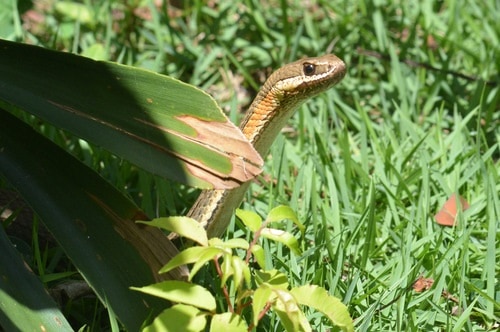
In different parts of the world, different snakes reign supreme over the locals. In traditional Thai villages, you can barely move without a golden flying snake landing on your head. In Central America, there’s a venomous fer-de-lance glaring at you from every forest. In northeast Brazil, the extremely abundant snake (yet little heard of) snake is the Paraguayan green racer, AKA Philodryas nattereri.
This species skips the Amazon rainforest, and lives in drier eastern Brazil, amid open cerrado grassland and bushland, usually with swaying tree clumps standing around. Their hotspot is undoubtedly northeast Brazil, where they coexist uneasily with venomous creatures like Caatinga coral snakes and Caatinga lanceheads.
Philodryas nattereri measures 100-130cm, with a maximum of 1.6 metres. They’re part of the 16 member Philodyras racer family, most of which are leafy green to blend with forests and the tree branches they weave along (see Lichtenstein’s green racer). But the Paraguayan green racer breaks this rule. While occasionally with green tinges, they’re mainly beige-brown, which is optimal for blending with drier open areas.
| 2 | Master of flexibility |
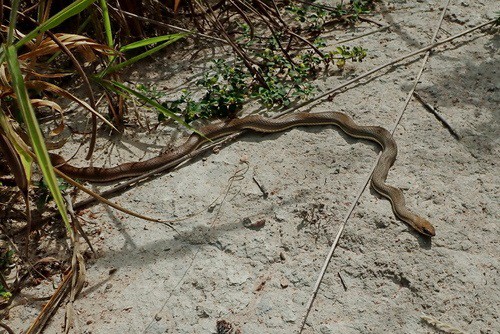
While Philoydras nattereri lacks a single knockout power, they’re a jack of all trades, and decent at all of them. This has allowed them to completely take over northeast Brazil. For example, a study from Brazil’s arid northeast found a mixture of everything. The green racers spent 73% of their time on the ground, 21.6% above ground (including trees and rooftops), and 5.4% underground. A couple of them fled to dark underground shelters when the scientists drew too close. Meanwhile, their cousin the Lichtenstein’s green racer sticks more closely to trees.
Paraguayan green racers were able to climb 7 metres above ground. Their hunting styles were also flexible. They commonly used constriction, applying a restraining jail cell of coils, but some relied on their rear fang venom to subdue prey. A large amount of P. nattereri were found dead on roads, killed by screeching tyres, their love of open areas proving to be their undoing.
Being so common, there’s no chance predators won’t arrive with interest. One confirmed P. nattereri predator is a fellow snake: Boiruna sertaneja, which was observed eating its prize on the roof of a pigsty two metres above ground.
| 3 | Extremely resistant to heat |
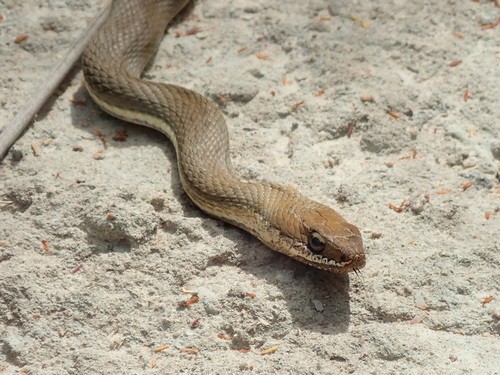
The Paraguayan green racer is a fast-moving species which charges down prey at blinding speeds, or sneaks up behind them, then lunges for a hind leg before rapidly applying coils. They’re an active forager rather than an ambusher which lurks for weeks by a leafy forest trail.
Like the US coachwhip, this species loves the warmest conditions. Some snakes will hunt in early morning or afternoon, then take a siesta at midday, which is too hot even for their reptilian bodies. Not Philodryas nattereri. The 2011 study from earlier found that their most active period was 11:00-12:59. Their main prey in this region was C. ocellifer, the whip-tailed lizard. This reptile was also active during the hottest part of the day, so Philodryas nattereri was tactically exploiting its love of warmth to secure food.
They weren’t completely immune, as on roasting days where the midday heat lingered for longer, they reduced their activity. But Paraguayan green racers have the ability to stride through savannah freely, worrying less about heat, while other snakes cower in their cool burrows.
| 4 | Monkeys hate them |
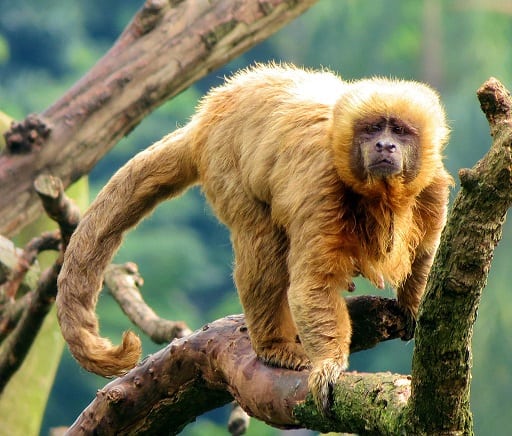
There’s one lesson that some Brazilian snakes learn the hard way: don’t mess with the local monkey tribe. The setting was a forest edge, 3 metres from a sugar plantation, in Brazil’s Paraiba province. The protagonists were a family of 30 blonde capuchin monkeys, a rare species rediscovered in 2006, estimated to number just 1,000 worldwide.
Scientists were tracking the monkeys when they heard screeching alarm calls, and saw adult monkeys heading towards an 93cm Paraguayan green racer. Soon, legions of monkeys were arriving, following the calls of their fellow kind. 9 adult males, 5 adult females, 5 juveniles and 1 infant monkey arrived to confront the intruder snake. The monkeys screeched and bared their sharp fangs, while some grabbed the branches surrounding the snake. The juveniles and infants stayed back, but did their duty and screeched as well.
Then one adult male took matters further: it grabbed the Paraguayan green racer, and sliced its body open with its sharp fangs. It then dropped the snake from a branch and left the area. The monkeys’ calls were audible for several minutes afterwards. The scientists later found the Paraguayan green racer completely dead, unable to survive an onslaught from 20 monkeys at once.
| 5 | Moves exclusively by day |
The study from earlier found that Paraguayan green racers were purely diurnal (the opposite of nocturnal). All observations while active were during the day, and none at night. All observations came between 7:00 and 16:59.
Paraguay green racers have a varied diet, taking meals from whatever family interests them in the moment. The same study tested 39 snakes, and found 26 prey within. Lizards contributed 68.75% of prey, followed by mammals at 18.75%. Then there was a reptile egg, a snake, an unidentified bird, and an amphibian each.
At 9 records, the white-tailed lizard ranked in first, followed by Peter’s lava lizard at 3. The top mammal was the red-nosed mouse, with 2 records. Their diet shifted with age, as juveniles ate reptiles exclusively, with mammals becoming more prominent in adulthood, with a healthy share of lizards maintained. Bats were also confirmed as prey in 2010, specifically the black myotis (Myotis nigricans), a species the Amazon tree boa also feeds on.
| 6 | Resistant to toxic toads |
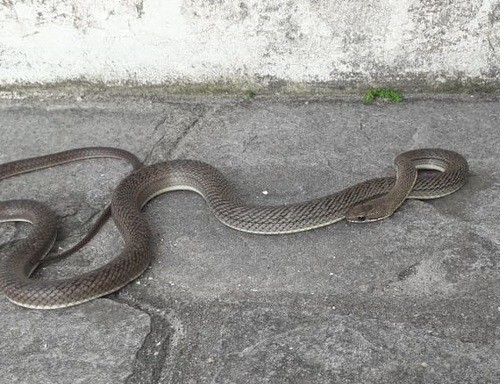
Paraguayan green racers are such flexible eaters that they can swallow lethally poisonous toads. It’s normally specialised amphibian eaters that do this, snakes whose physiology has adapted over millions of years, snakes whose very cell is designed to prevent from bufotoxins from binding. But Paraguayan green racers are so hardy that they can swallow them anyway. They’ve been observed eating the likes of granular toads and cururu toads, both poisonous. They can swallow them even if they inflate, gripping their balloon-like bodies with sharp fangs, and swallowing them by the head.
However, Philodryas nattereri doesn’t always get its own way. A popular prey is Peter’s lava lizard (Tropidurus hispidus), a thick, scaly beast which is also confirmed prey of the venomous Caatinga lancehead. In 2012, scientists found a dead Paraguayan green racer along a road in Brazil, measuring 110.5cm. Dissection revealed a lava lizard in its stomach, which weighed 40 grams versus the snake’s 146 grams, making for a prey mass of 41.4% of its own body weight.
The snake wasn’t punctured, like catfish-eating snakes suffer. The scientists speculated that the thick, bulky body of the lizard compressed the snake’s lungs from within, choking it to death.
| 7 | Venom: only partially researched |
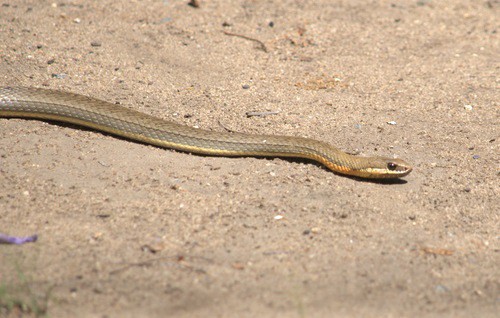
The Paraguayan green racer has a mainly proteolytic venom, causing the structural breakdown of proteins into their base amino acids. There’s also minor fibrinolytic properties, shredding the fibrinogen that helps blood to clot. Its venom composition was similar to its cousins, the Patagonian and Lichtenstein’s green racers.
Unlike coral snakes, there are few neurotoxins in Paraguayan green racer venom. At 45.9%, the main ingredient was PIII metalloproteineases, which primarily cause local symptoms. These were in intermediate concentrations compared to fellow family members, the Patagonian green racer (52.6%), burrowing night snake (39.1%), and Miranda green racer (58.4%).
Actual bite reports are few and far between. Their cousin, Lichtenstein’s green racer, caused a fully swollen hand in a reptile expert in 1986, plus stiffness extending to the shoulder, and random knee pain and stiffness for several days. If the venom composition is similar, then P. nattereri could have similar effects. Either way, this species contributes virtually nothing to Brazil’s annual snakebite statistics.
One study tested mice, injecting them with raw Philodryas nattereri venom. Two symptoms predominated: edema (swelling) and myonecrosis, the decay of muscle tissue, which peaked at 2 hours.
| 8 | Eats 4 confirmed snakes |
So far there are four observations of Philodryas nattereri eating fellow snakes. The first happened in northeast Brazil’s Rio Grande do Norte state, and its prey was a Oxyrhopus trigeminus, AKA Brazilian false coral snake. The false coral had a bulge, like it had recently eaten. The Philodryas nattereri didn’t care about getting two meals in one, and slithered up and bit the false coral on the upper third of its body. It rapidly applied three constricting coils. While the false coral struggled to free itself, it didn’t bite back in self defence, giving the racer an easy ride. The whole event ended when the scientists spooked the P. nattereri, causing it to flee.
The second observation was far simpler. Scientists found a Philodryas nattereri in the grounds of an ecological station in Rio Grande do Norte. Upon dissection, they found an annulated cat-eyed snake in its stomach, measuring 50cm. This is an extremely common tree snake found across a huge swathe of Brazil, with a moderate dangerously venom capable of swelling a human hand.
The third sighting was then a brown vine snake (Oxybelis aeneus) found in a Paraguayan green racer’s stomach in 2009. Finally, there was the big 2011 study from earlier, which recorded a Lema’s striped snake. P. nattereri seizes fellow snakes if the urge arises, but doesn’t rely on them.
| 9 | Gobbles up nest chicks (or tries to) |
The old diet study from earlier found 1 bird, relatively few, but an alternative study from Brazil’s northeast Caatinga region found plenty. One racer actually perched on a cactus to peruse the insides of a bird’s nest. Philodryas nattereri was inventive and cunning. Some wrestled with adult birds, while others slithered up tree trunks, weaved along branches and stole unsuspecting chicks from nests. The smallest chicks were swallowed in 30 seconds flat.
They reserved constriction and chewing in a mild venom for larger, more formidable birds. They weren’t immune to the perils of flapping feathers either. Like their cousin, Lichtenstein’s green racer, birds like Sayaca tanagers often ganged up and targeted Philodryas nattereri in a squawking onslaught, forcing them to retreat.
In one observation, a racer ate three chicks in succession, taking 32, 48 and 72 seconds for each. Then there was a heartwarming failed attempt, where a 150cm green racer slithered towards a nest, but knocked the nestlings to the ground, after which their parents immediately arrived to assist them. The snake backed off in disappointment.
| 10 | The Paraguay question |
The Paraguayan green racer has one of the most misleading snake names ever. Firstly, they’re not green, and secondly, it was doubted for decades whether they existed in Paraguay at all. Eastern Brazil, especially the northeast, are its heartlands. The iNaturalist map of user sightings has 214 dots, and none in Paraguay as of today (February 2024). No official records existed that far south, until 2011.
Scientists roamed a cerrado bushland with their eyes open, just waiting for things to write a 240 page report about. They found a dead snake caught in a small mammal trap, measuring 125.7cm. Soon after, they found a 132.5cm female on grassy, sandy cerrado, and a 105.2cm male, which they both captured by hand. All 3 proved to be Paraguayan green racers, actually in Paraguay. These sightings extended their confirmed territories 365km southwards. The previous known closest spot to Paraguay was Anastácio, Brazil.
In 2016, a gigantic evolutionary tree released, showing connections and divergences of thousands of snakes. The closest relative of the Paraguay green racer, of all 3900 snake species on Earth, proved to be the Miranda green racer (Philodryas mattogrensis). Though much greener, this acts similarly: a fast-moving snake which pursues its prey, swapping between forest and open ground. The miranda green racer is found primarily in Paraguay, and parts of far southern Brazil.
